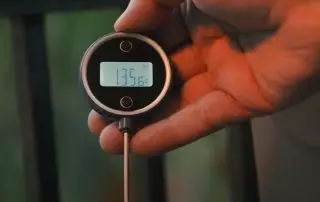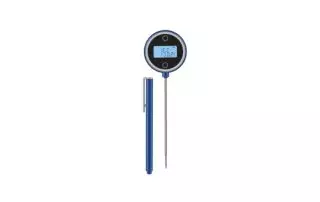Ideal cooking temperature
Fish and Seafood Temperature Chart
Fish is not only delicious but also healthy. A healthy diet should always contain some fish.
Check our temperature charts for preparing your favorite fish recipes

Fish and Seafood Internal Temperature Chart
As with any other type of meat like chicken or pork, food safety is incredibly important when cooking seafood. Different types of fish and seafood require different internal temperatures, so keeping a seafood temperature chart on hand is essential.
By learning the proper cooking temperatures and using a quality food thermometer, you can enjoy delicious seafood dishes without worrying about foodborne illness. Always keep in mind that your fish will continue to cook slightly after it’s removed from the heat, so it’s important to let it rest for a few minutes before doing a final temperature check.
Fahrenheit and Celsius Cooking Temperatures
Internal Temperature Description
| Type | Internal Core Temperature in Fahrenheit |
Internal Core Temperature in Celsius | Internal Description |
|---|---|---|---|
| Fish Whole – Steaks – Fillets |
Fish is slightly translucent and flakes easily, | ||
| Salmon | 130°F to 135°F | 54°C to 57°C | Salmon has almost no collagen. This means it will start to lose moisture more quickly than beef. |
| Halibut – Cod – Red Snapper- Sea Bass – Tilapia | 130°F to 135°F | 54°C to 57°C | |
| Trout | 135°F to 140°F | 57°C to 60°C | |
| Tuna – Swordfish – Marlin | 125°F | 51°C | Cook Tuna until medium-rare (do not overcook or the meat will become dry and lose its flavor) |
| Ahi Tuna (Sashimi grade) | 115°F to 120°F | 46°C to 49°C | Ahi Tuna is most often served rare or seared rare. This is because the longer you cook it, the more flavor and moisture it loses. Sashimi grade tuna has been flash frozen to kill any parasites. |
| Shrimp | 120°F | 49°C | Cook until medium-rare and the shrimp just start to turn pink (do not overcook or the shrimp will become dry and lose its flavor). |
| Medium-size, boiling | 3 to 4 minutes | ||
| Large-size, boiling | 5 to 7 minutes | ||
| Jumbo-size, boiling | 7 to 8 minutes | ||
| Lobster | 145°F | 62°C | Place thermometer in the tail to check the internal temperature. Lobster requires a high temperature than other fish since its muscle fibers are longer and require more heat to shrink. |
| Boiled or Steamed, whole Lobster | 145°F | 62°C | |
| Grilled Lobster | 145°F | 62°C | |
| Baked, Grilled or Broiled Lobster Tail – each | 140°F | 60°C | Shell cut – piggyback lobster tail (lobster meat is exposed). |
| Scallops | 120°F | 49°C | Sear, bake, or broil each side for approximately 4 minutes or until an instant-read cooking or meat thermometerinserted into their centers reach 115 degrees F. Remove from heat. The carryover cooking will add another 10 to 15 degrees, for an ideal final temperature of 125 to 130 degrees F. They should also have lost their translucence and turn opaque. |
| Clams – Mussels – Oysters | Cook clams, mussels, and oysters until their shells just open. Throw away the ones that do not open. | ||
| Crab Cakes | 150°F to 155°F | 65°C to 68°C |











